This cake costs $220, at the time of writing.
This is the single most expensive (unaged) cake that I have ever encountered. This is, therefore, a rather special encounter (for me, anyway). I devote a few hours on a calm Saturday morning to exploring this remarkable cake.
Is it remarkable for anything other than its price? We shall see...
Small leaves, densely compressed and heavily fragmented
I previously likened Hailanghao to the bowels of Pandemonium, that infamous city where the fallen angels set up shop. This is because I believe that Hailanghao attempted to step up into the "premium" brand bracket, after successfully making chunky, fun cakes that represented the top of the mainstream bracket - but they did so without a particularly great increase in quality. Or, perhaps rather more accurately, the prices that were being asked for Hailanghao after a certain point in time rapidly diverged from the actual quality of the tea.
This cake represents the zenith of this particular divergence. Indeed, it represents the zenith of all unaged pu'ercha pricing that I have ever encountered - Internet-based, Maliandao, Taobao, High Street shop.
I alternate between Zidu ("purple belly", my usual pu'ercha pot) and Gertrude (my celadon gaiwan), simply because I hadn't tidied the latter away following my recent Yisheng sessions.
The dry leaves are surprisingly compressed - my 10g sample comes from the centre of the bing, and the leaves are small and heavily fragmented. This is at odds of the photographs at Yunnan Sourcing, where it is being sold, which show large, deluxe leaves.
However, the dry leaves have a massively minty aroma. They really smell of menthol. It is a remarkable aroma. (I often take the presence of a cooling sensation to indicate a decent proportion of laoshu [old tree] maocha in the blend.)
(The "gushu" in the cake's name means, of course, "ancient tree".)
(The "gushu" in the cake's name means, of course, "ancient tree".)
The aroma is - unsurprisingly - minty in the extreme. It has a long, constant sweetness that sits in the aroma cup without dissipating.
In the mouth, the first impression is the quick, high fruitiness - springtime, lively, enjoyable. The minty body then rapidly asserts itself. These leaves are, undoubtedly, laoshu to a great extent. The blurb on the merchant's web-page describes it as being 100% laoshu, picked under the supervision of Hailanghao's owner. This could, for once, be true. It's like drinking mint.
Within minutes, my nose is entirely clear, and I am breathing cold blasts of menthol air through each nostril.
The leaves in my sample - chopped and small
This is an interesting tea. I am glad to have tried a sample, but I cannot say that I actually enjoyed it a great deal. There is a sour note that dwells in the body that stops me from falling in love, and it is rather monotonic. Unlike other pure laoshu that I have tried from Laobanzhang and Xinbanzhang, it isn't particularly charming.
Hailanghao may certainly have acquired good leaves, but there is something not entirely satisfactory here that prevents me from loving it. (This is before we consider the $220 price tag.)
My dear wife passes by and grabs a cup: "This is quite simple", she notes.
While it does have plenty of laoshu characteristics, it is entirely one-dimensional. Whereas the previous laoshu banzhang leaves that I have tried have been one-dimensional (because they come from a single source), that one dimension has been clean, leathery, sweet, and buttery. By way of contrast, this Hailanghao's one dimension is more of a straight, sweet sourness with little more than its menthol character to commend it.
While it does have plenty of laoshu characteristics, it is entirely one-dimensional. Whereas the previous laoshu banzhang leaves that I have tried have been one-dimensional (because they come from a single source), that one dimension has been clean, leathery, sweet, and buttery. By way of contrast, this Hailanghao's one dimension is more of a straight, sweet sourness with little more than its menthol character to commend it.
Its provenance is not in doubt, but provenance alone does not necessarily a good cake make.
The advertised leaves - full, large, and whole
So, at the end of it, I am grateful to have had the opportunity to buy a single session's exposure to another example of Laobanzhang leaves, but, in this case, I am left with the impression that is how one should not make a laoshu bing.
If you happen to be the proprietor of Yunnan Sourcing: I appreciate your store very much, but please look away now.
For the rest of us: $220 for this cake (1,400 RMB!) is, I am afraid to say, barking mad.

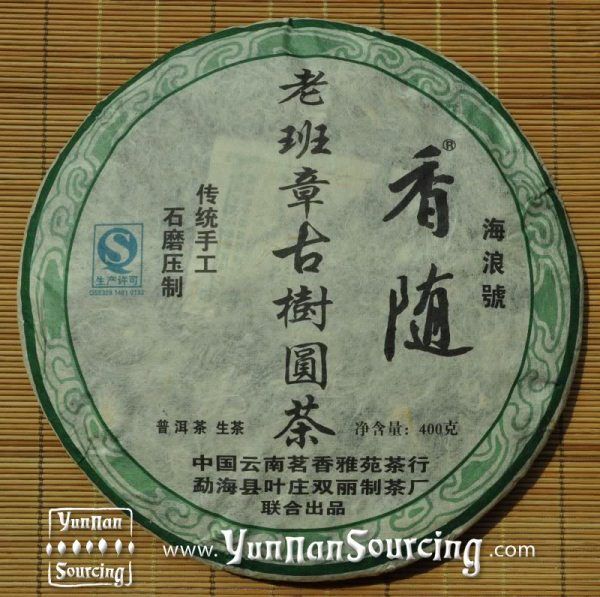
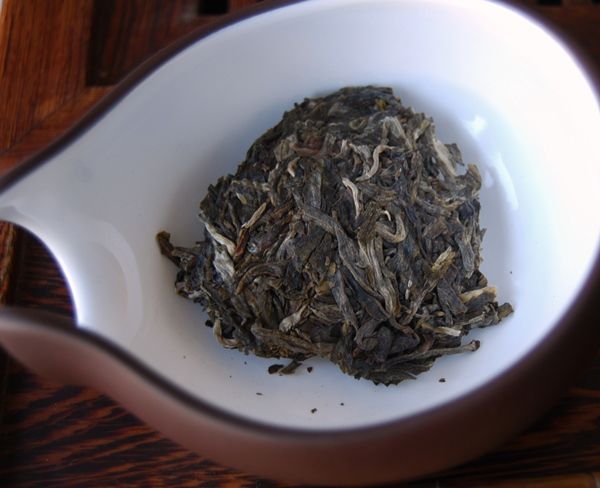

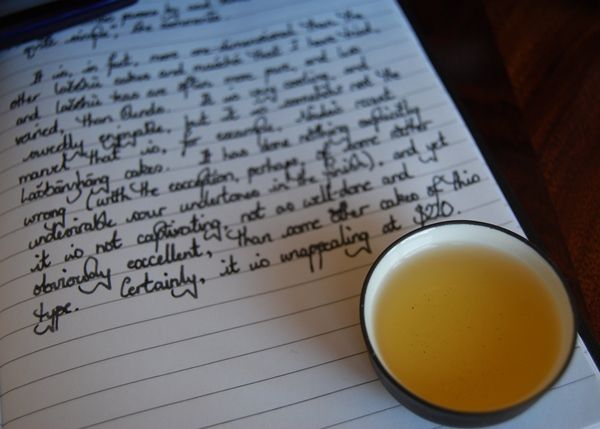
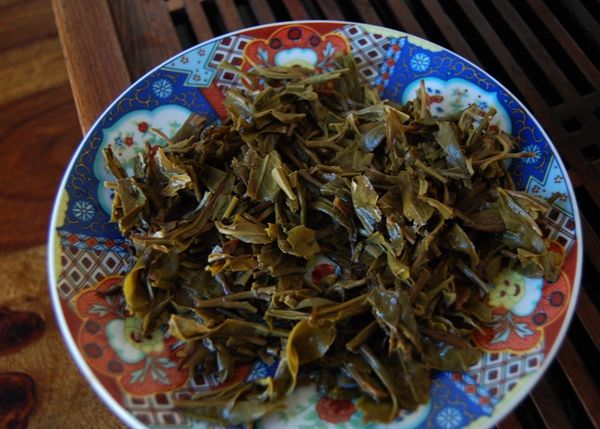
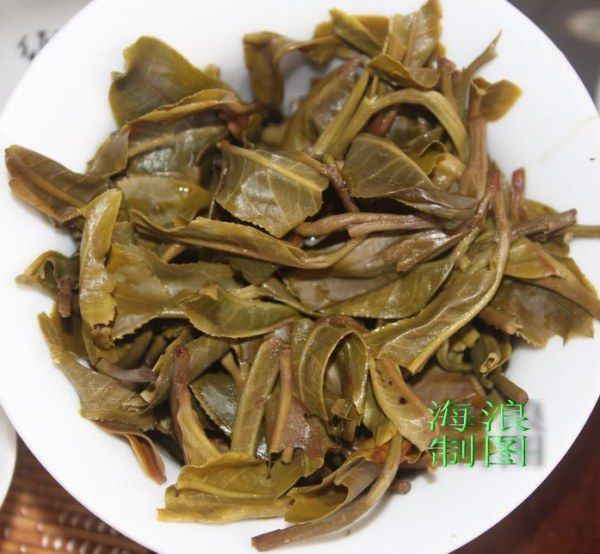
7 comments:
Haha... that's OK... I kept reading anyways!
I definitely agree this is an expensive cake. The picture of the leaves that we feature on the site was taken by Hai Lang himself while the tea was still in mao cha form. Perhaps I should have made that distinction. In the future I will.
Just for the record I don't set the price for Hai Lang's cakes. Any people who re-sell them have to agree to sell at the price set by Hai Lang. My general feeling is that this tea is excellent, but is it 3.25x better than my Wan Gong Yi Wu? :-)
I think anyone sane is avoiding Lao Ban Zhang this year... last I heard mao cha has exceeded 2000 RMB per kilo.
I am curious... what was the weather like when you drank this tea? And what was the weather like when you drank the Wan Gong Yi Wu?
Scott
Jim from Puerhshop has said that Banna has been nuts in terms of prices this year.
--shah8
Dear Scott,
Thanks for the reply. I'll be honest, your Wangongzhai is much more enjoyable that dear Mr. Hailang's mightily-priced production, and, as you pointed out, a fraction of the price. Two cakes of HLH, or a tong of Wangognzhai? An easy decision.
Regarding the weather, I think it's been pretty stable of late: warm and balmy, quite moist. It's a great time of year to drink shengpu. :)
Avoiding Laobanzhang may, as you wrote, be a wise idea. Or perhaps more accurately, if one only has a set budget, there is so much more for one's money in other regions. I must admit, "LBZ" can be delicious.
Dear Shah,
I get that impression, yes. Having said that, LBZ leaves are always show-stoppingly expensive. Bear in mind that this is a 2010 cake, too. Given the drought-like conditions for 2010, I am fairly cautious about investing heavily in cakes from that year.
Toodlepip,
Hobbes
Agreed on 2010. Nada's teas (and YS Yongde) were the only 2010 I've bought (and I'm thinking I really should have bought another Bulang). Tho' I really try to buy several years old pu, since those are battle-tested on many people's tastebuds.
XZH's 2010 lineup, from what I could make of the translation, was not very inspiring... $136 Hekai? Well, I suppose it's probably very good, but the best of a minor region usually isn't as good as a mediocre specimen of a good region.
That said, LBZ is ridiculous. I'm not a huge fan of it, because it can be too smooth and vapid for me despite the power, Nada's Banpen isn't so dissimilar to LBZ, without the flourishes and depth, and I've had similar issues. I still love the rougher Banzhangs, though, like Ban'E.
--shah8
LBZ has always been ridiculous -- has been since 2006.
Hey Hobbes,
Great review. I tasted this tea in Kunming with Hai Lang and I have to say, I thought it was a great tea. That said, I went ahead and bought a couple cakes of the '09 because I thought it was the better deal.
I noticed you note that the tea was sour and you said the same thing about Scott's Spring Jie Liang. I haven't found either to be sour. However, I think your weather may be playing a part.
I have been drinking off of a Bingdao cake that I love, and have finished about half the cake on. This past week, I had 3 straight days of sour tasting tea with weird acidic/metallic taste on the back of my tongue on the finish. I looked at the cake and didn't notice anything different, but on a hunch I went upstairs and got my temp/humidity gauge. Sure enough within an hour it had leveled out at 85% humidity where I drink tea. I immediately moved the tea that I have downstairs (usually a couple cakes to drink off of) to the upstairs storage. The next morning I woke to 59% humidity in that room and took the tea downstairs. The tea was good again.
With it being the Plum Rain season in Shanghai, it is very humid. However, my wife was limiting my A/C use downstairs where I drink tea. She said it was giving her a headache. Since I noticed the humidity issue, I take whatever tea I am drinking upstairs at the end of the night and bring it back down in the morning. She is also allowing me to turn on the A/C at night in that room, so it is a bit drier in the morning. This has resolved all the sourness thus far.
Btw, I drank the Jie Liang again yesterday. Seriously, a good tea. If you have some more, I would say try it again when the weather is a bit more dry and the pressure in the air is lower. That tea will surprise you.
-DP
Dear DP,
How fascinating - thanks for the comments. I'll give the Jieliang another run when it's less rainy here, as you suggest. You never know!
Toodlepip,
Hobbes
Post a Comment